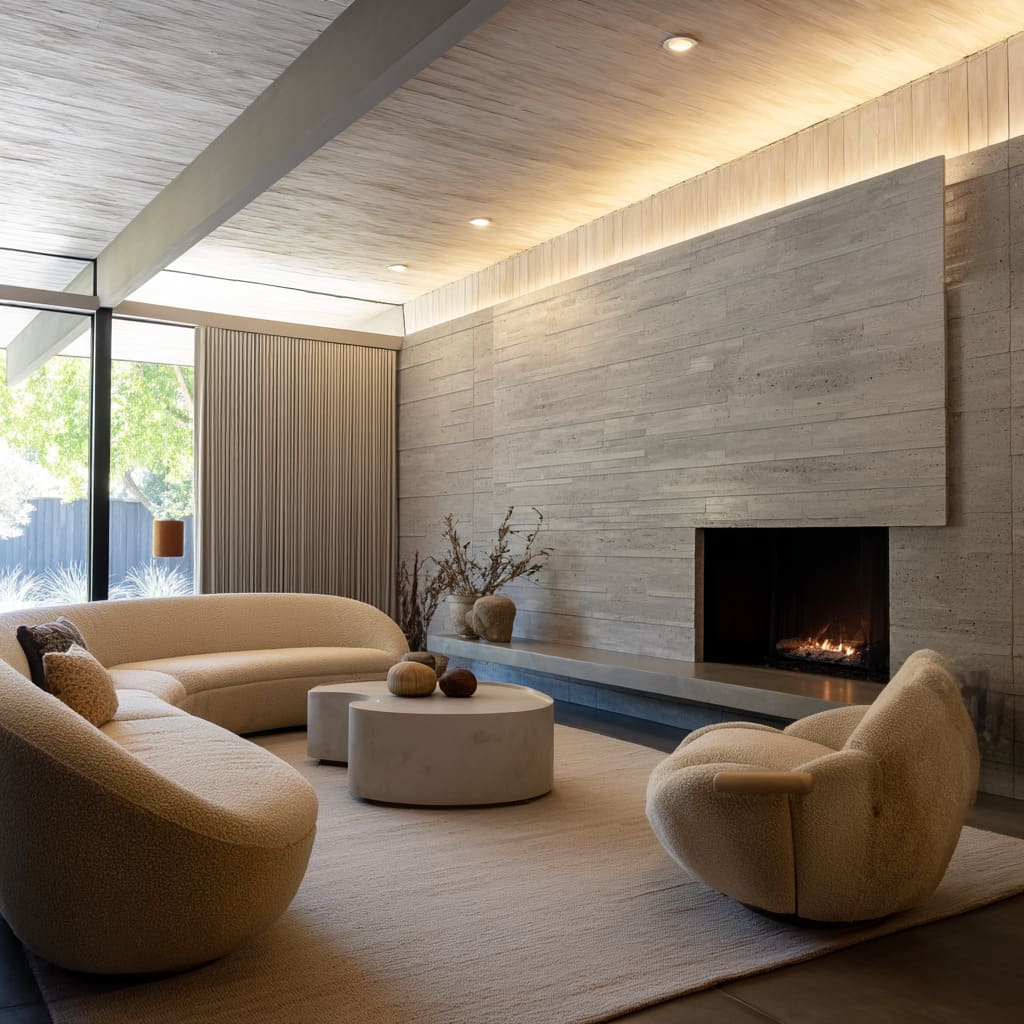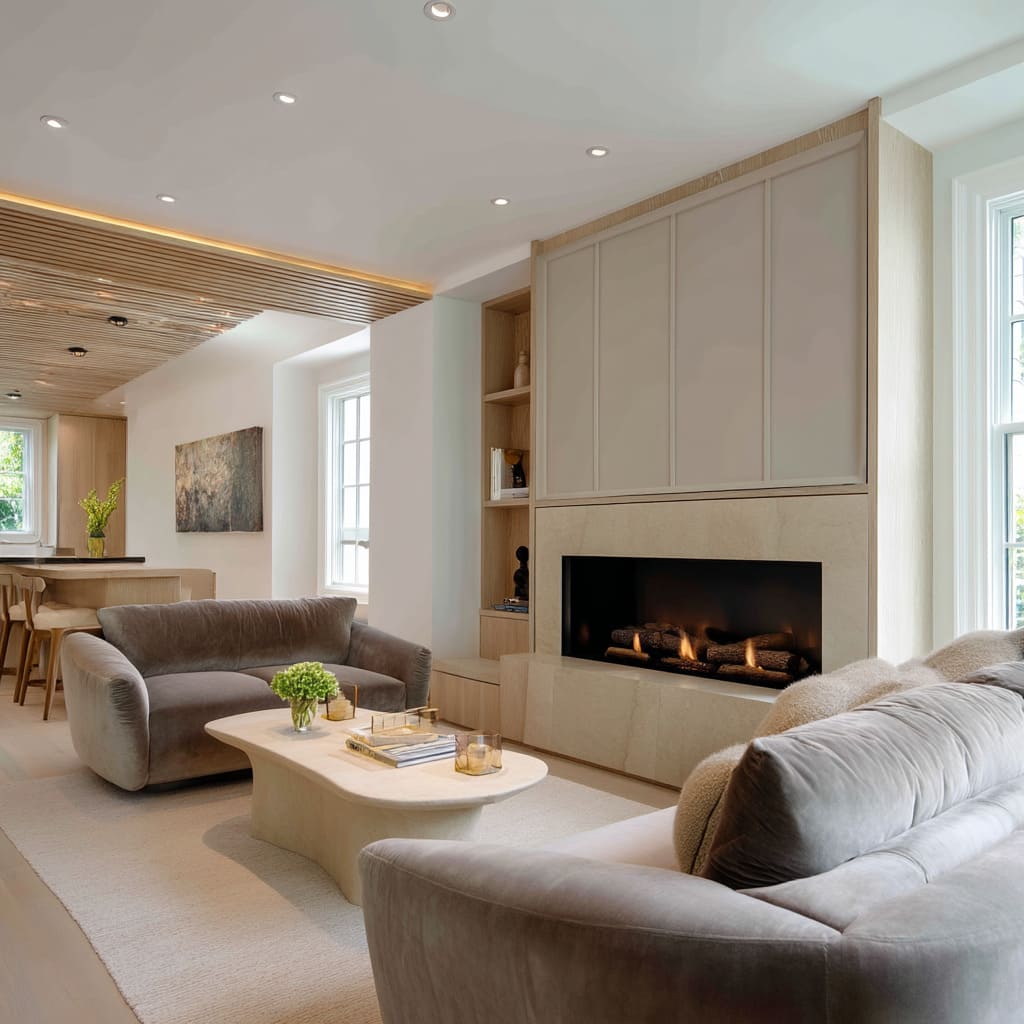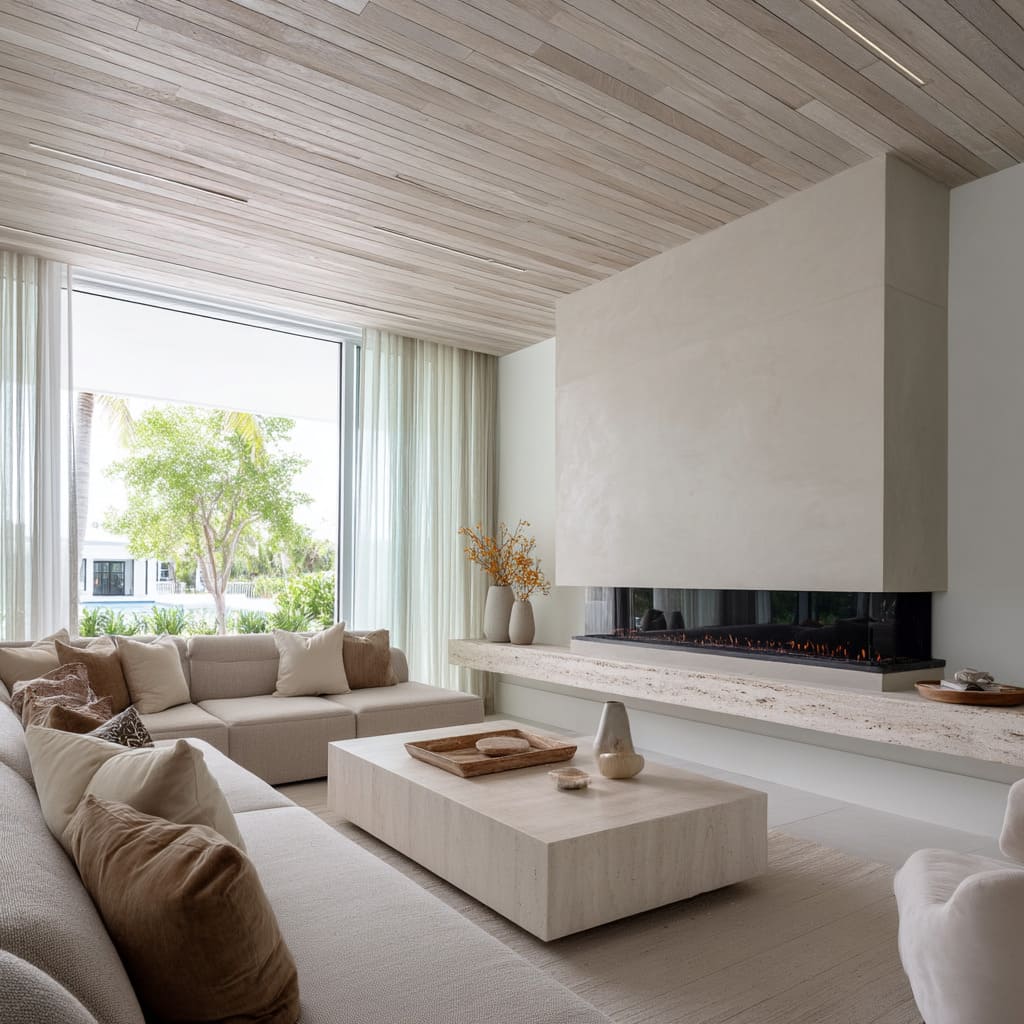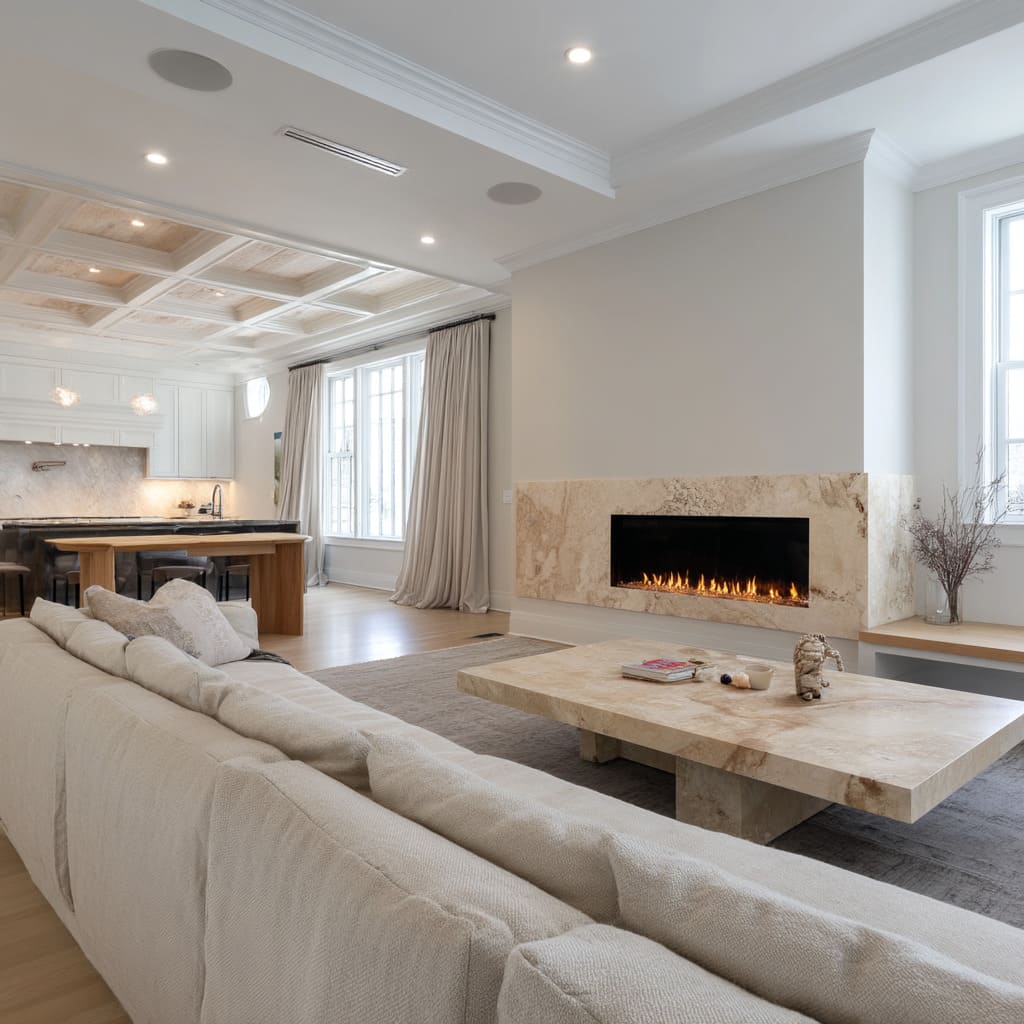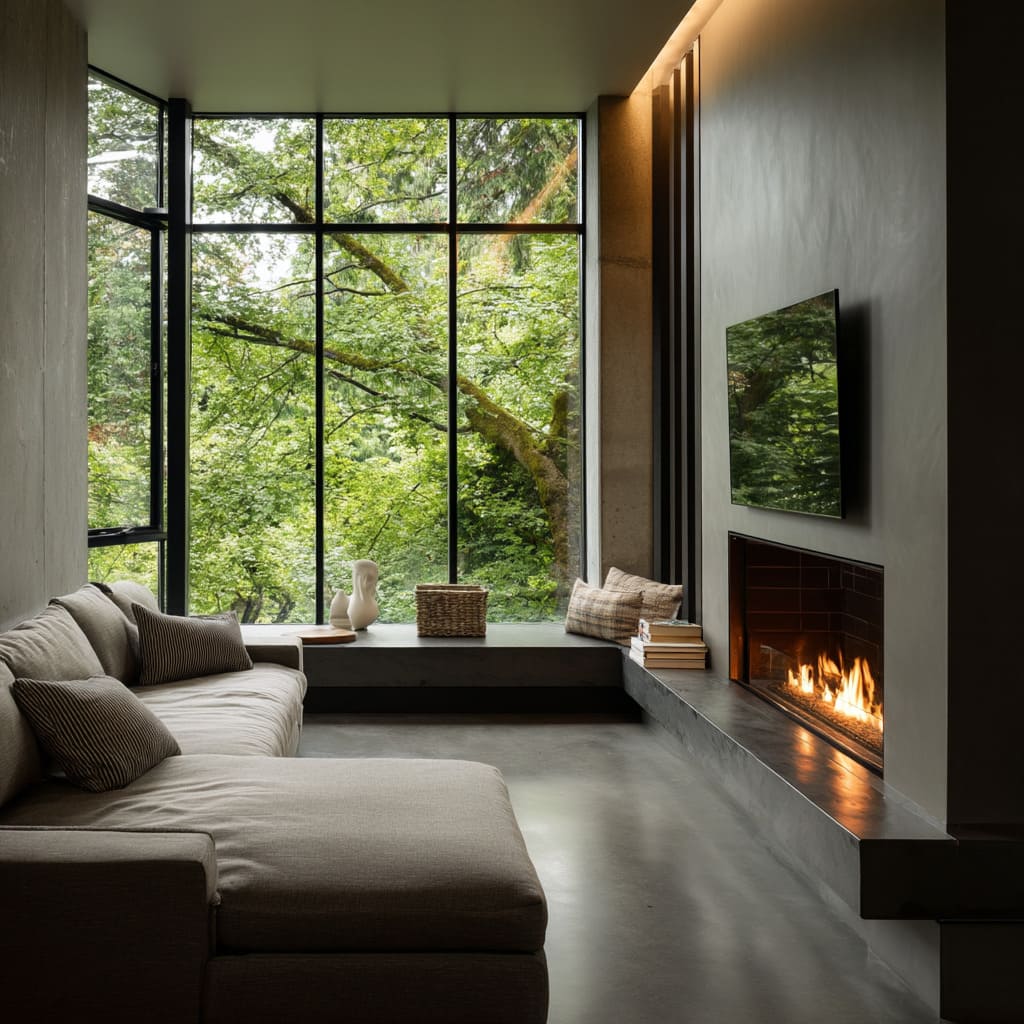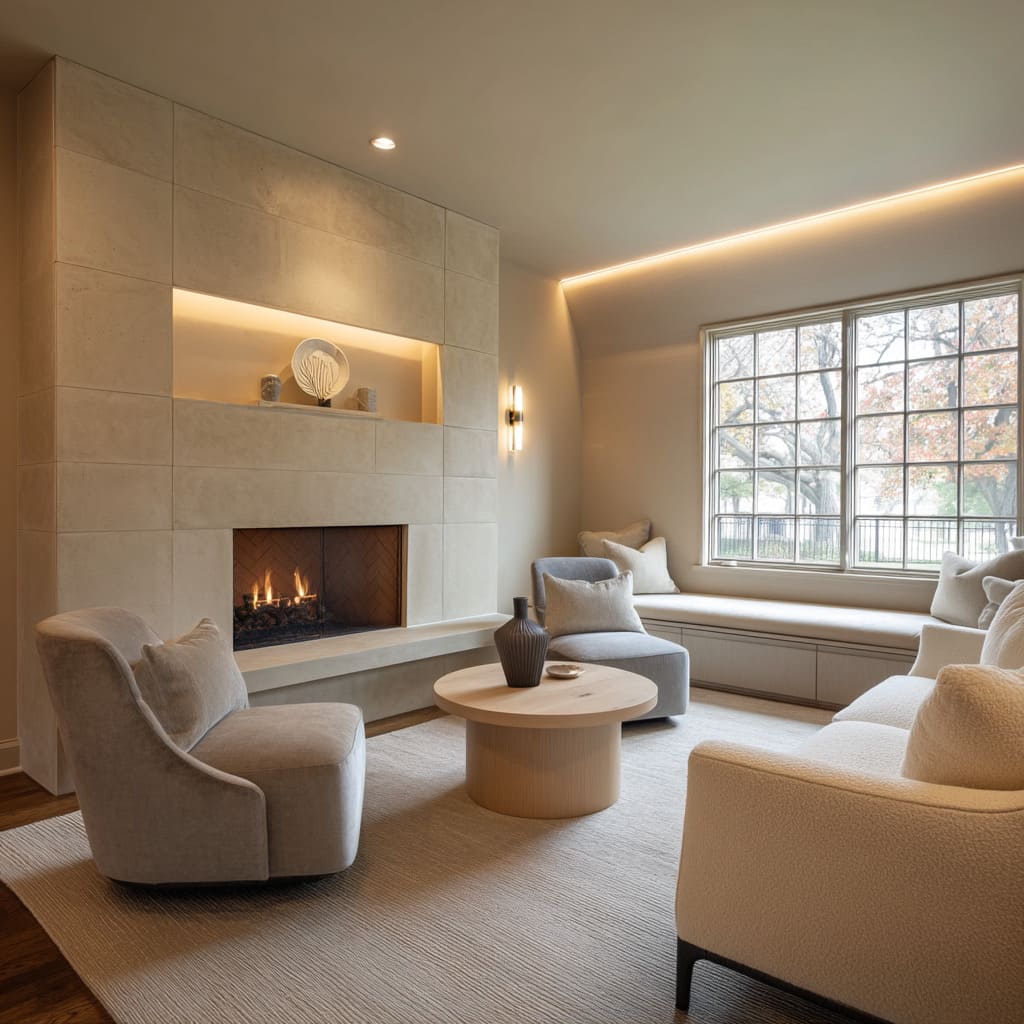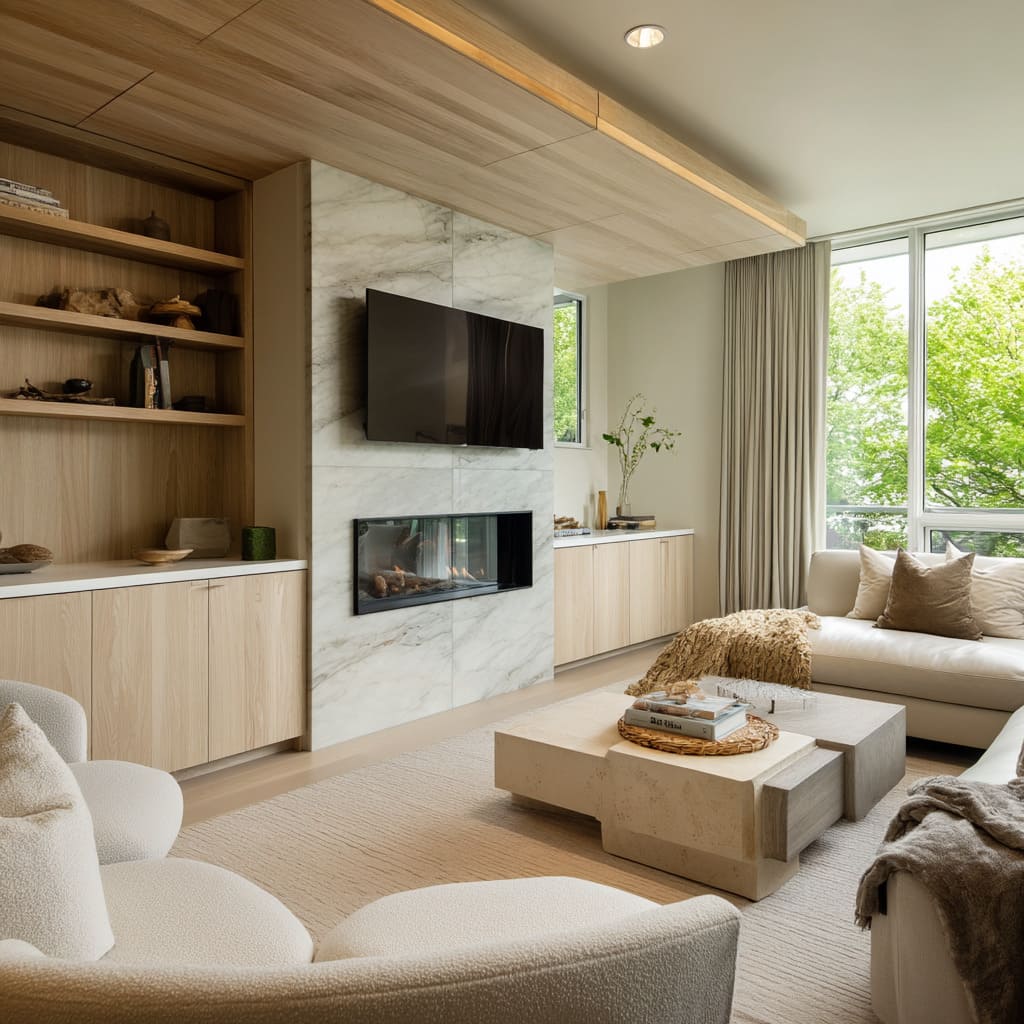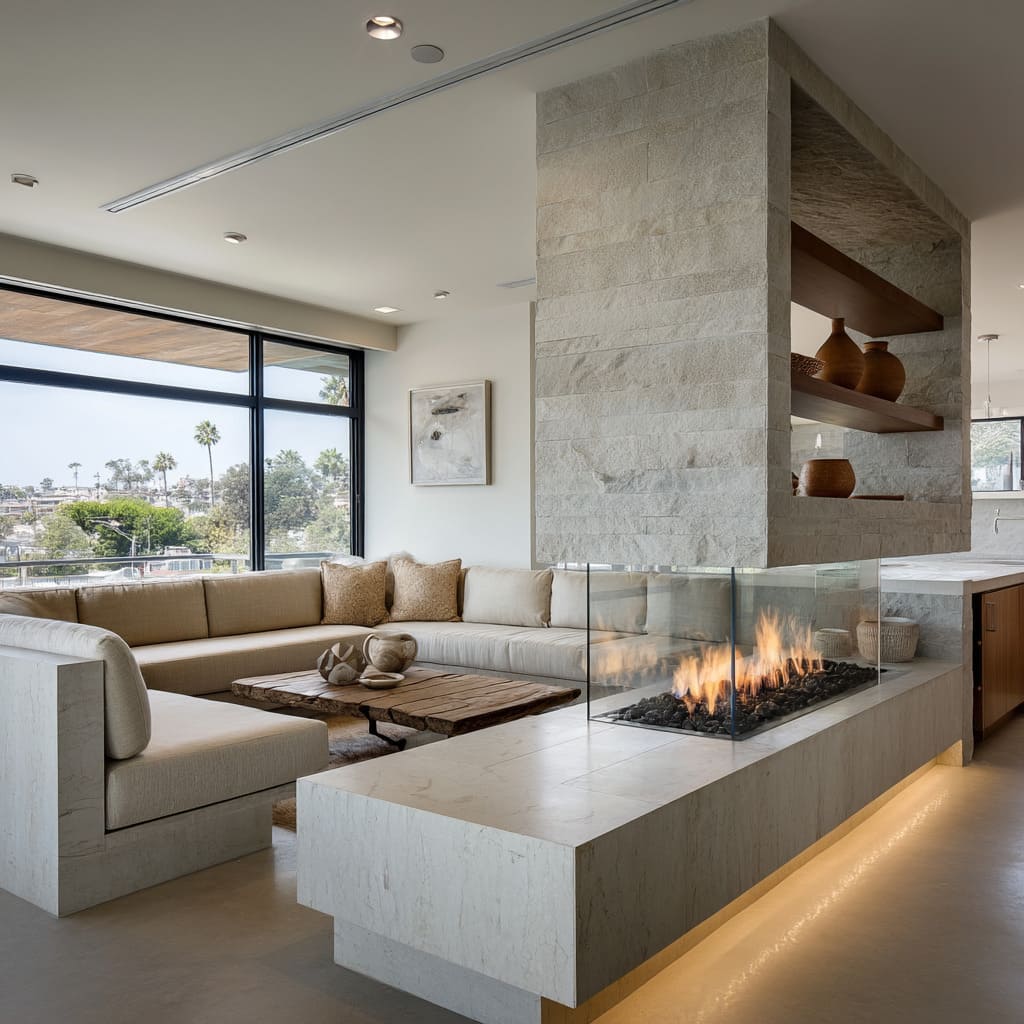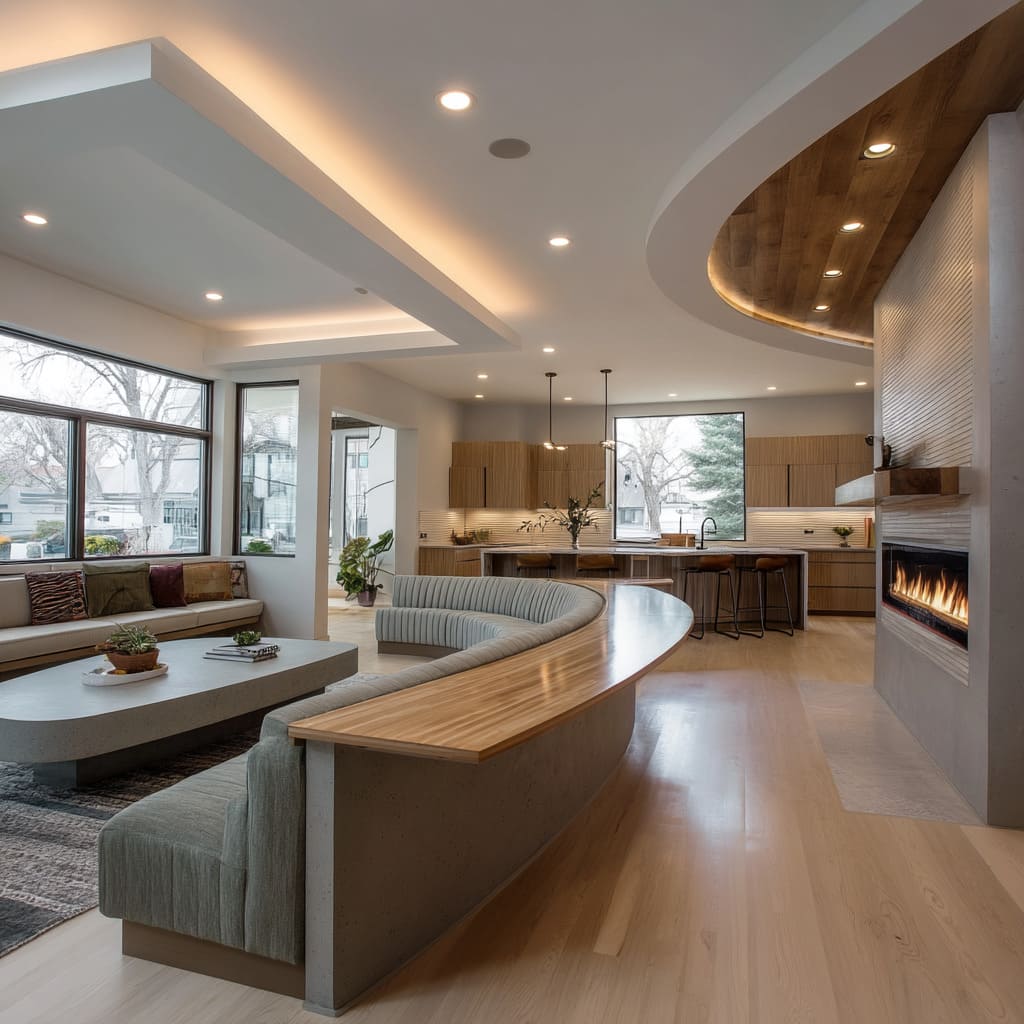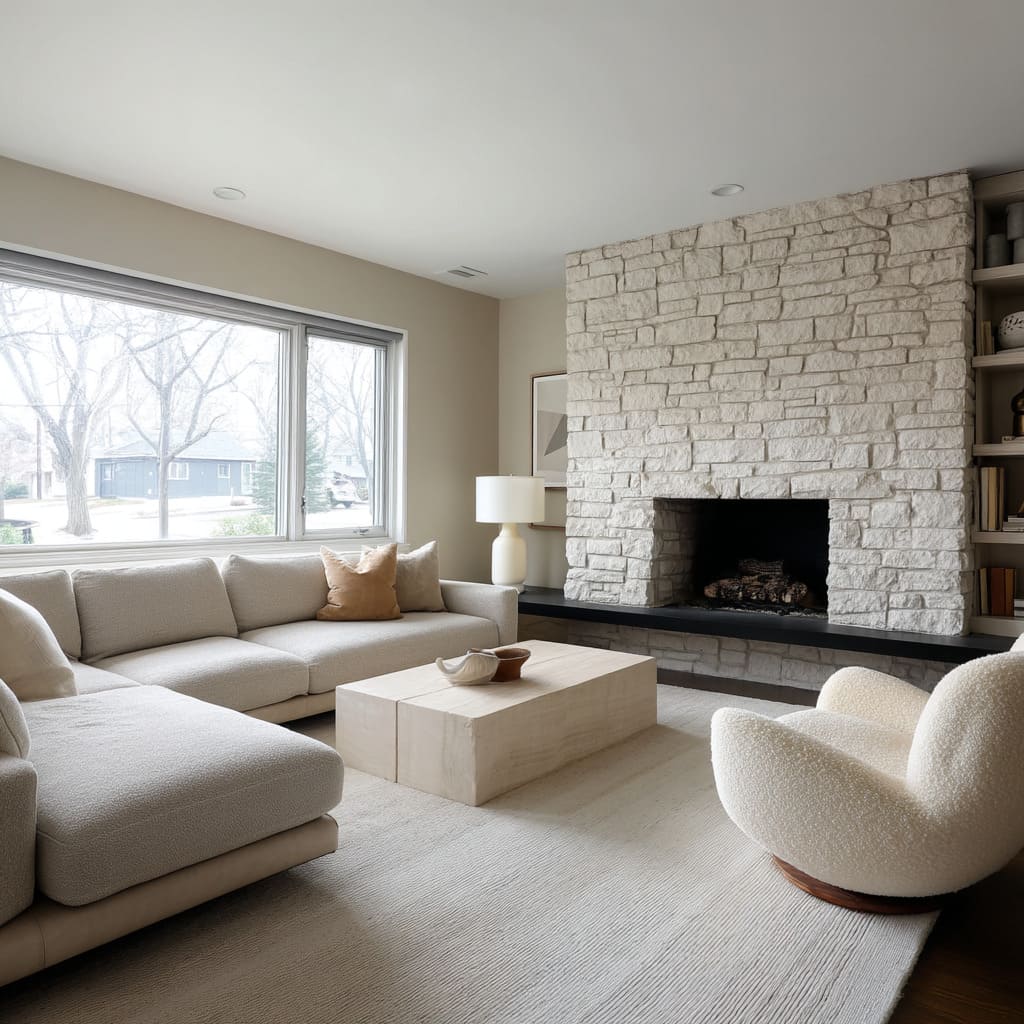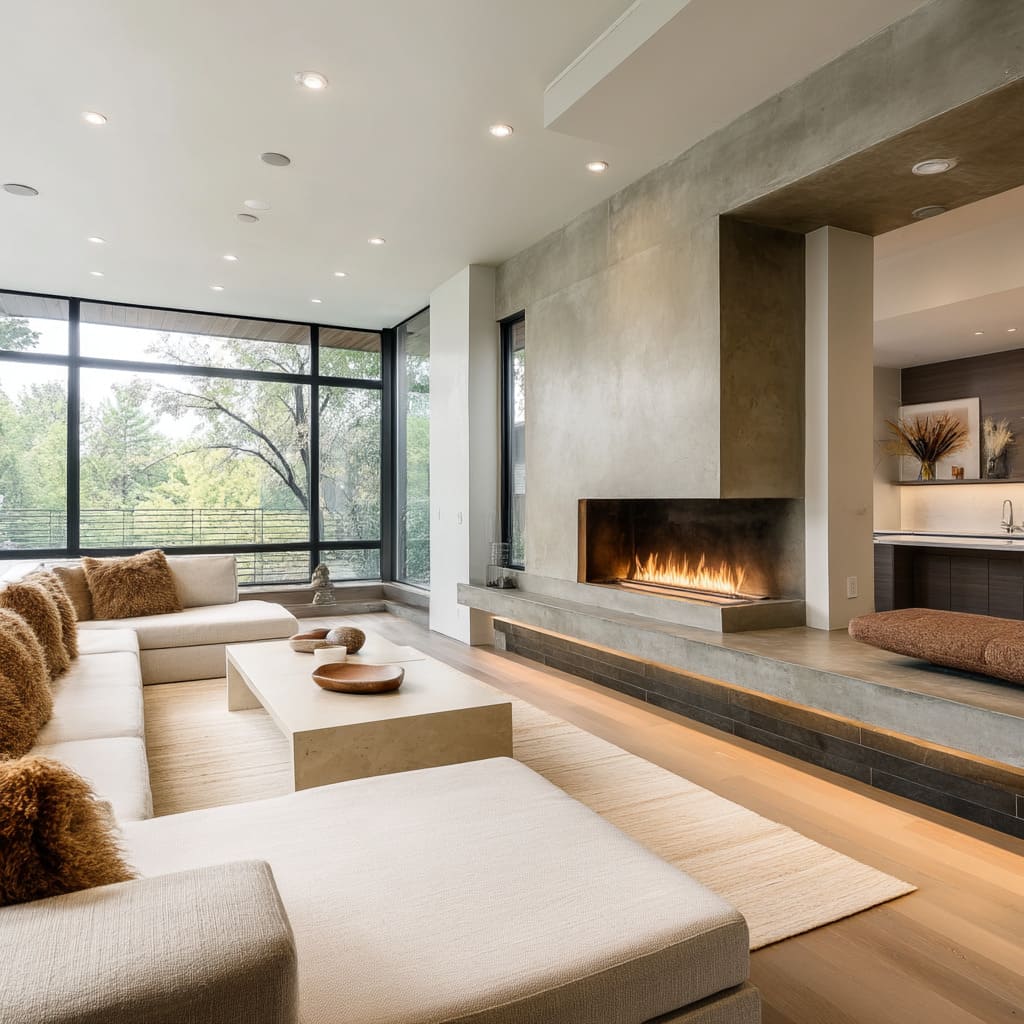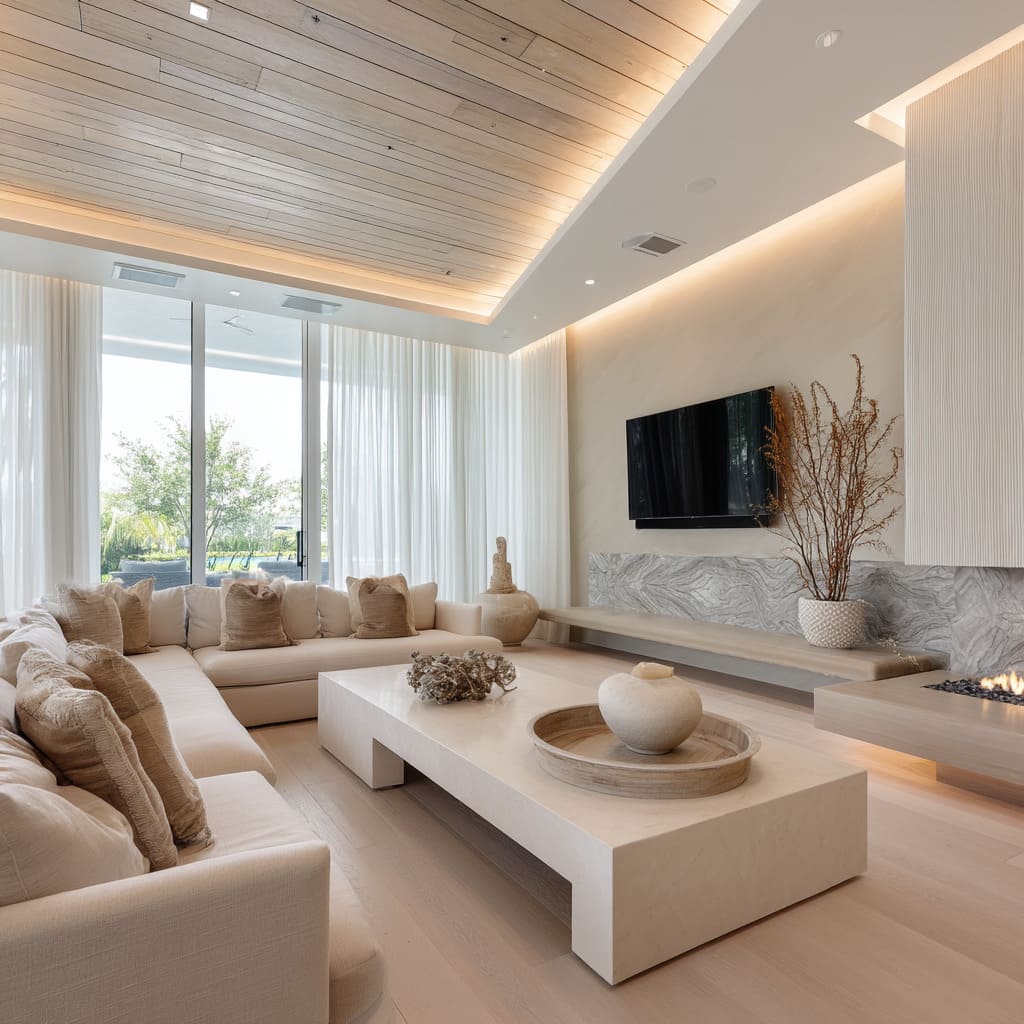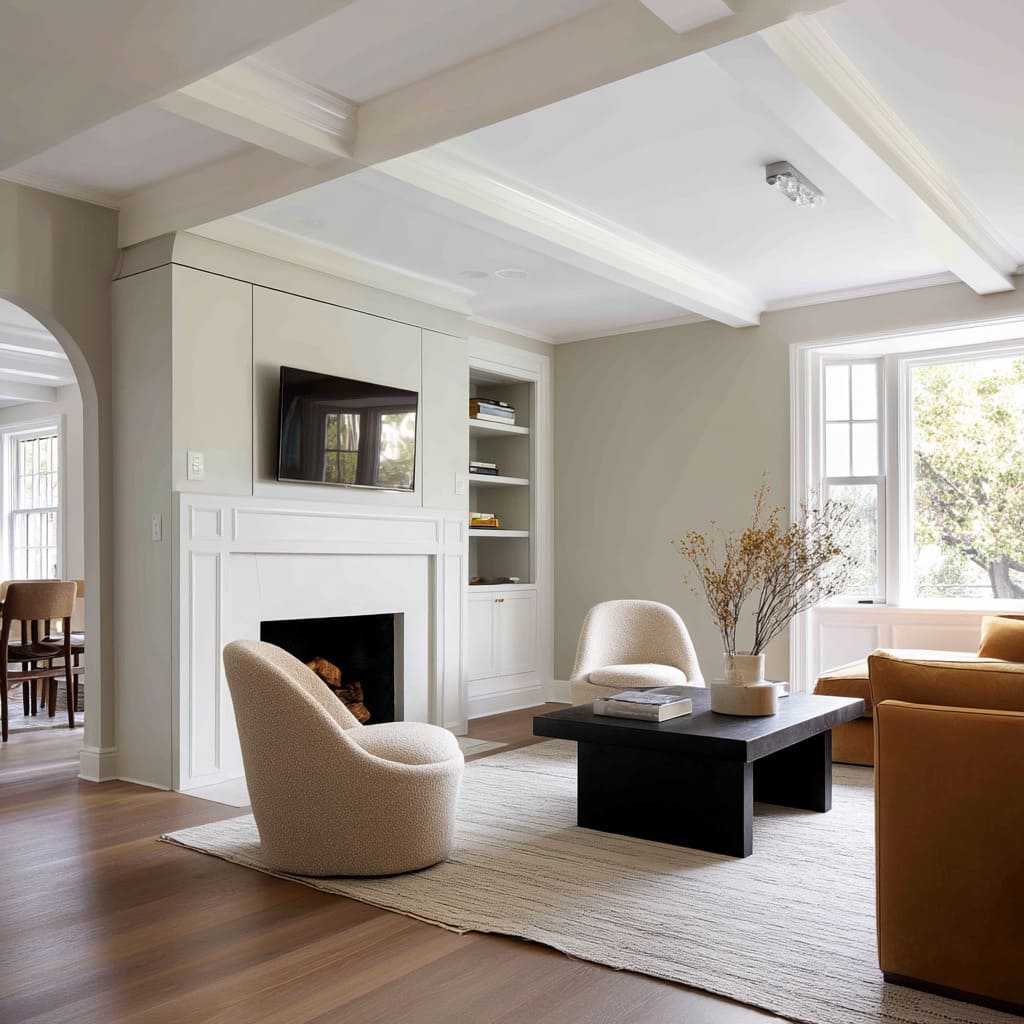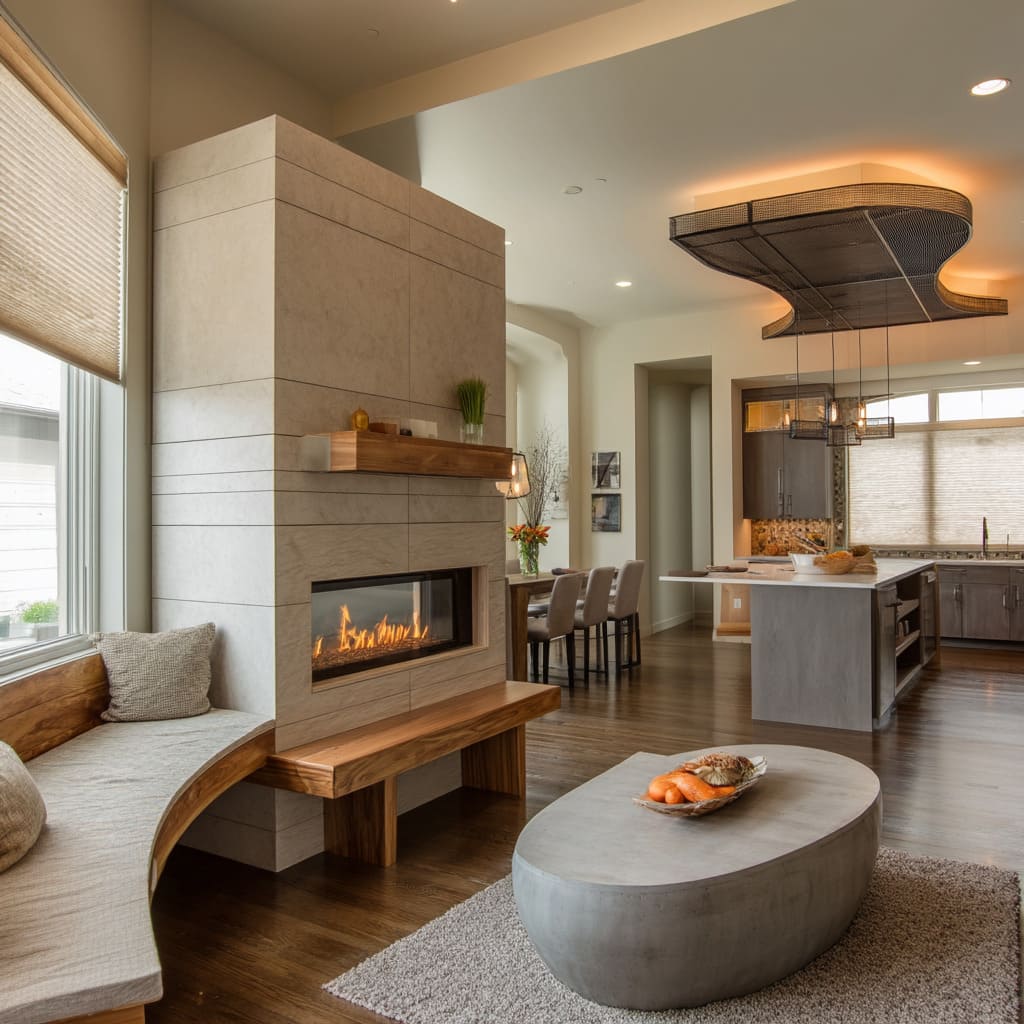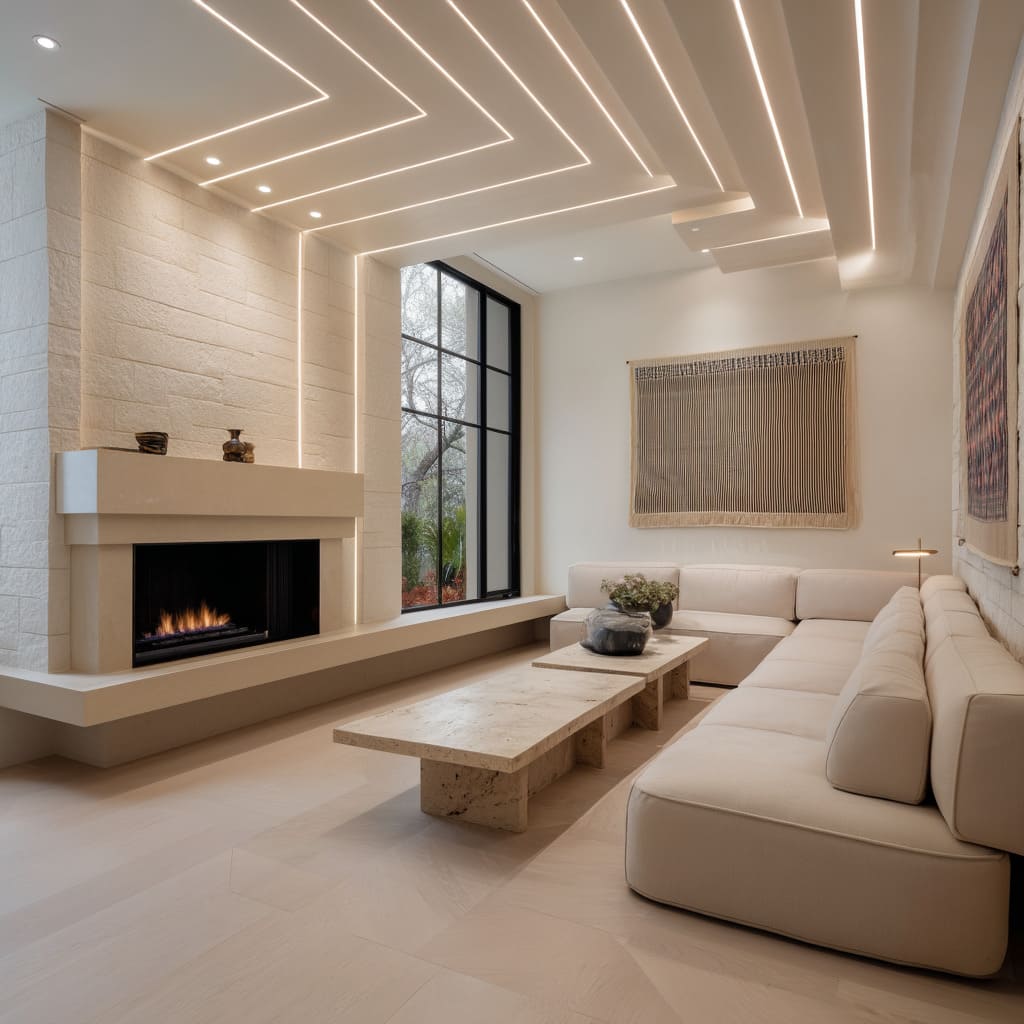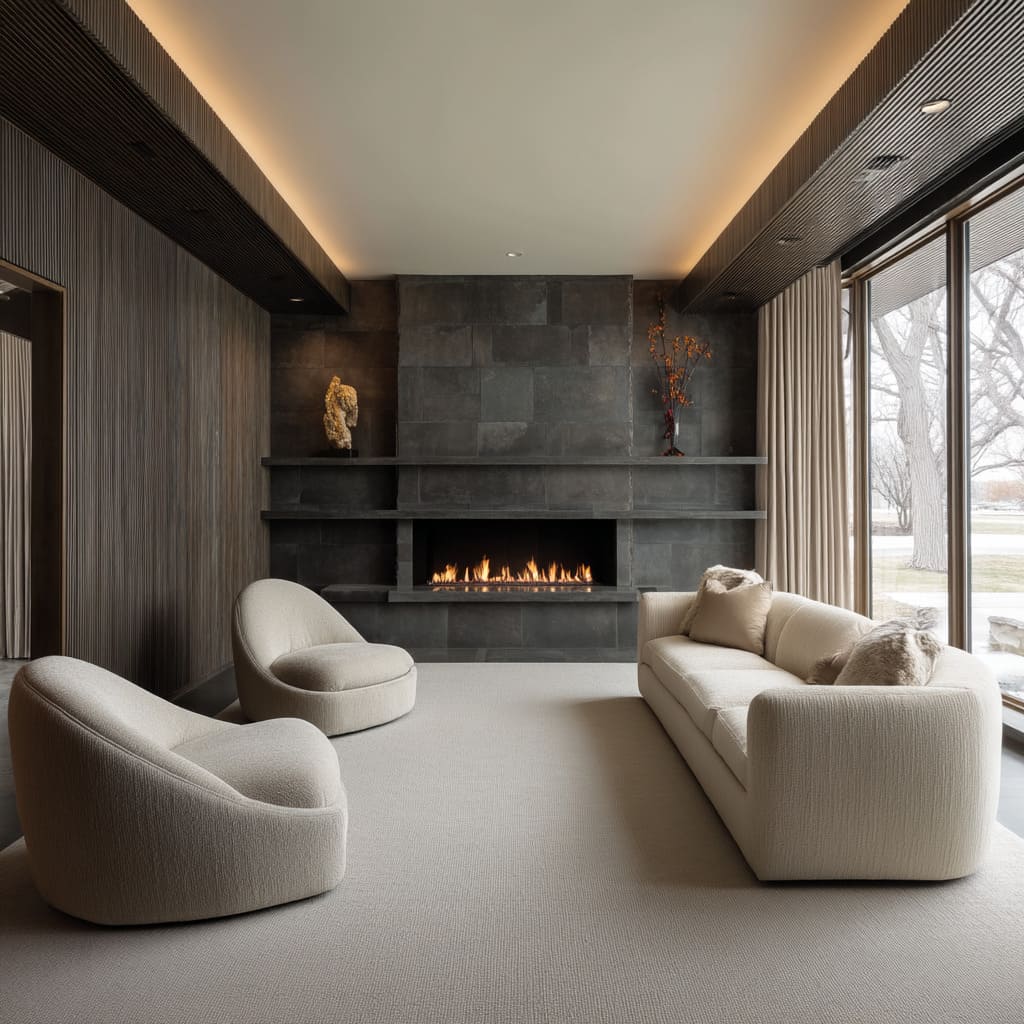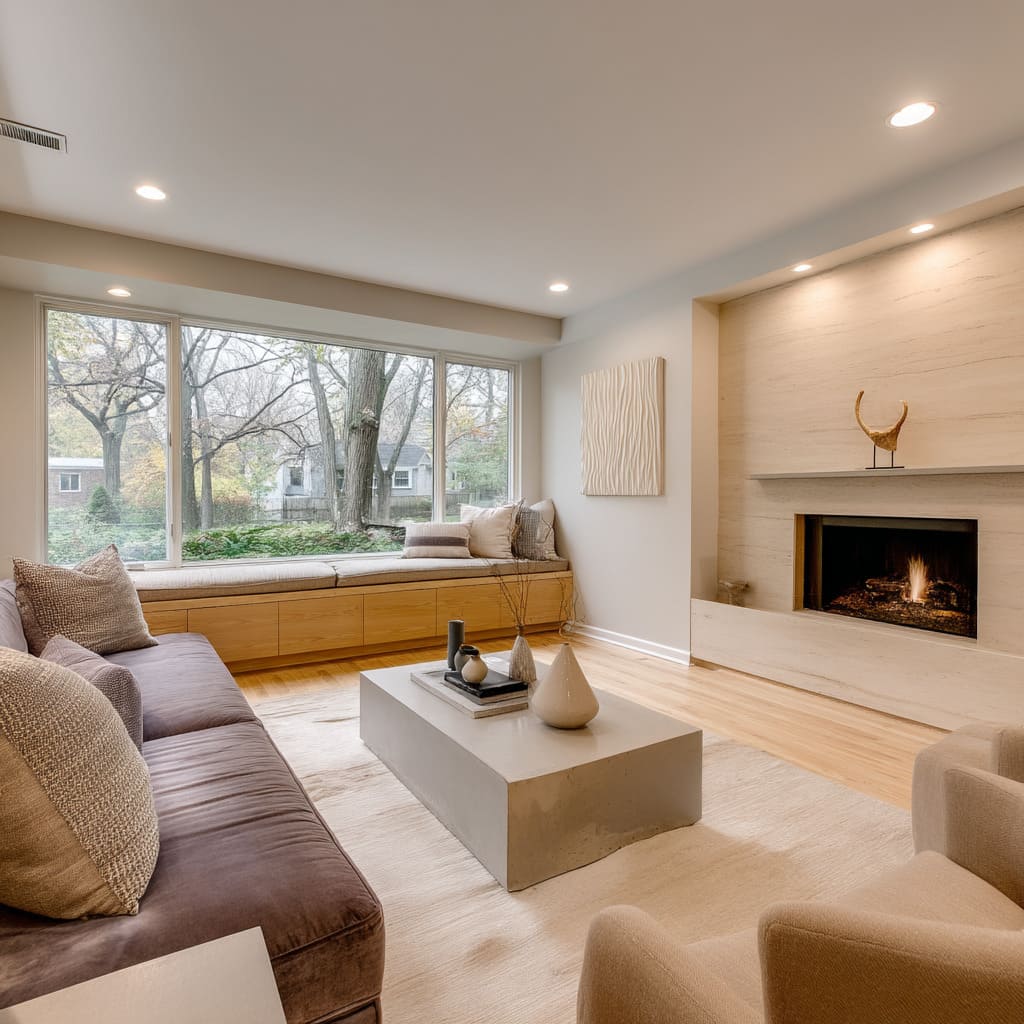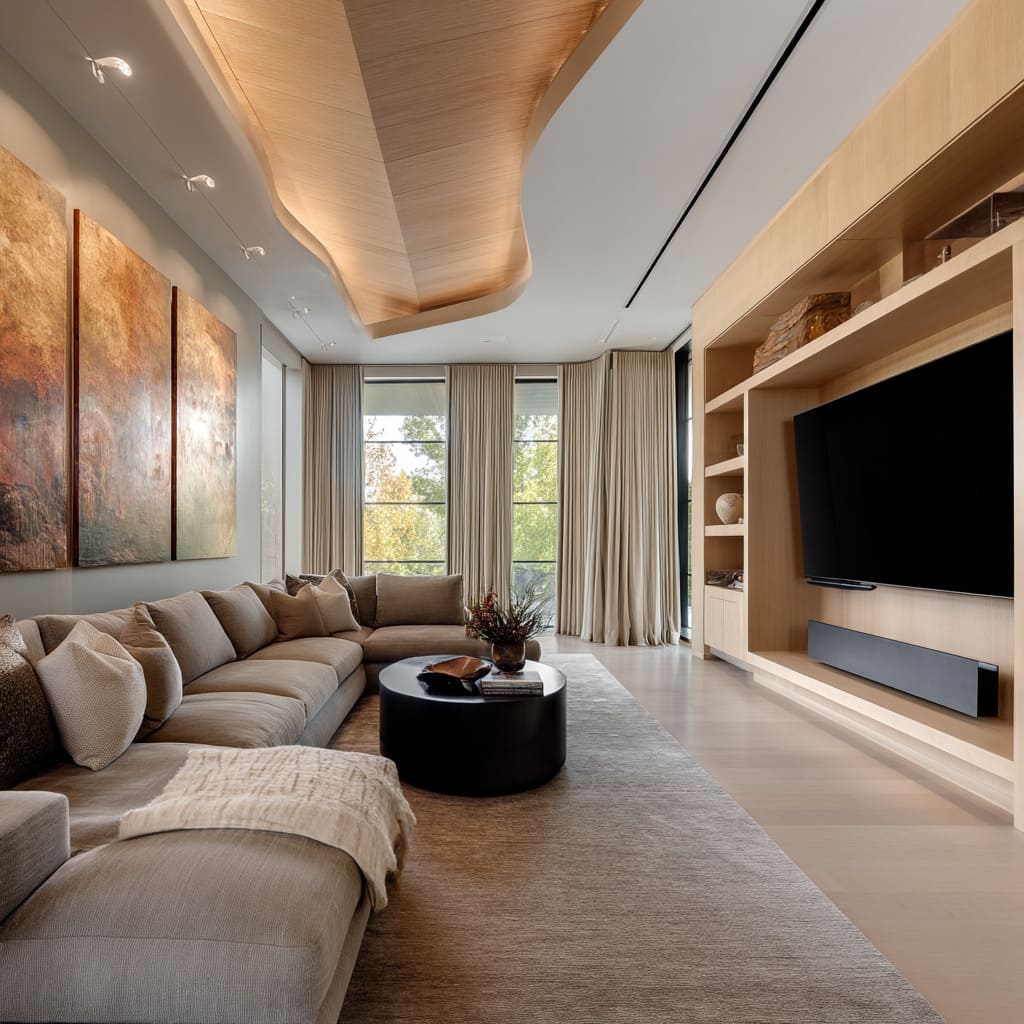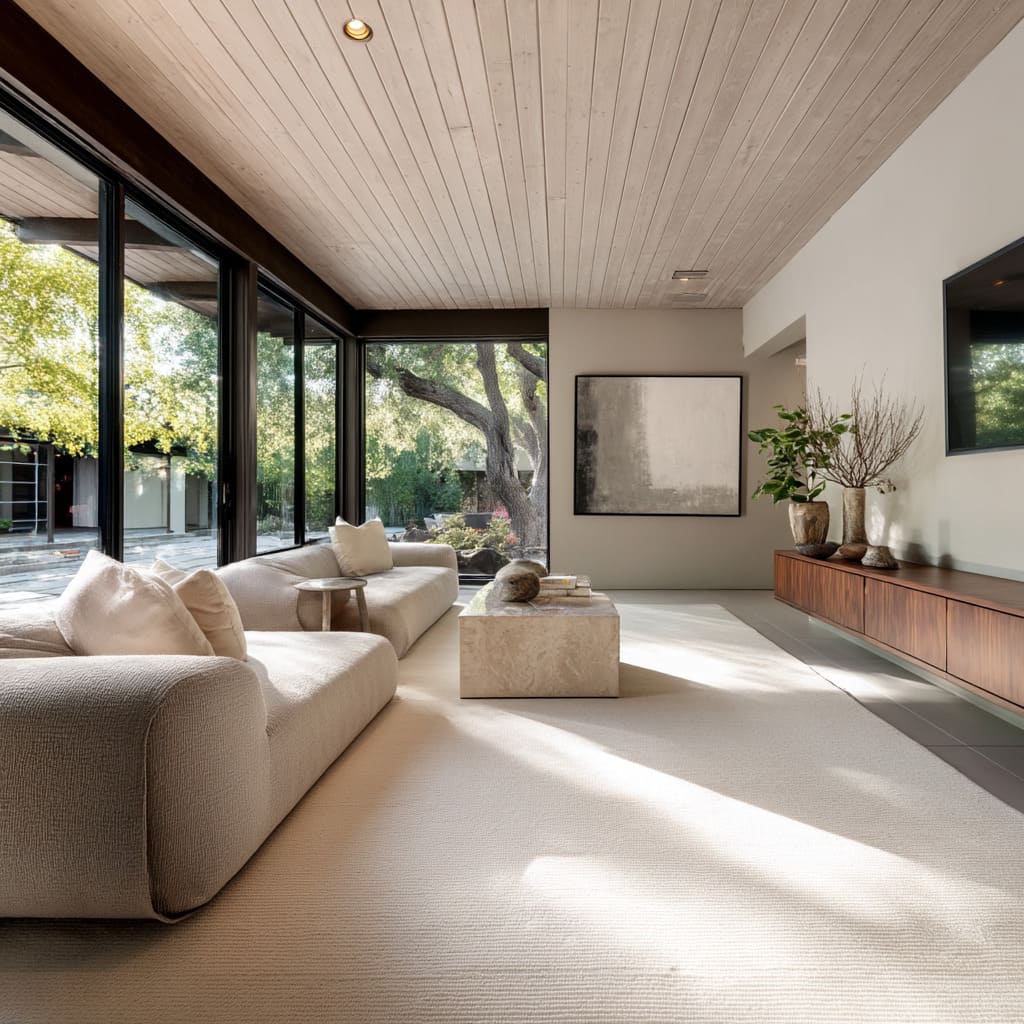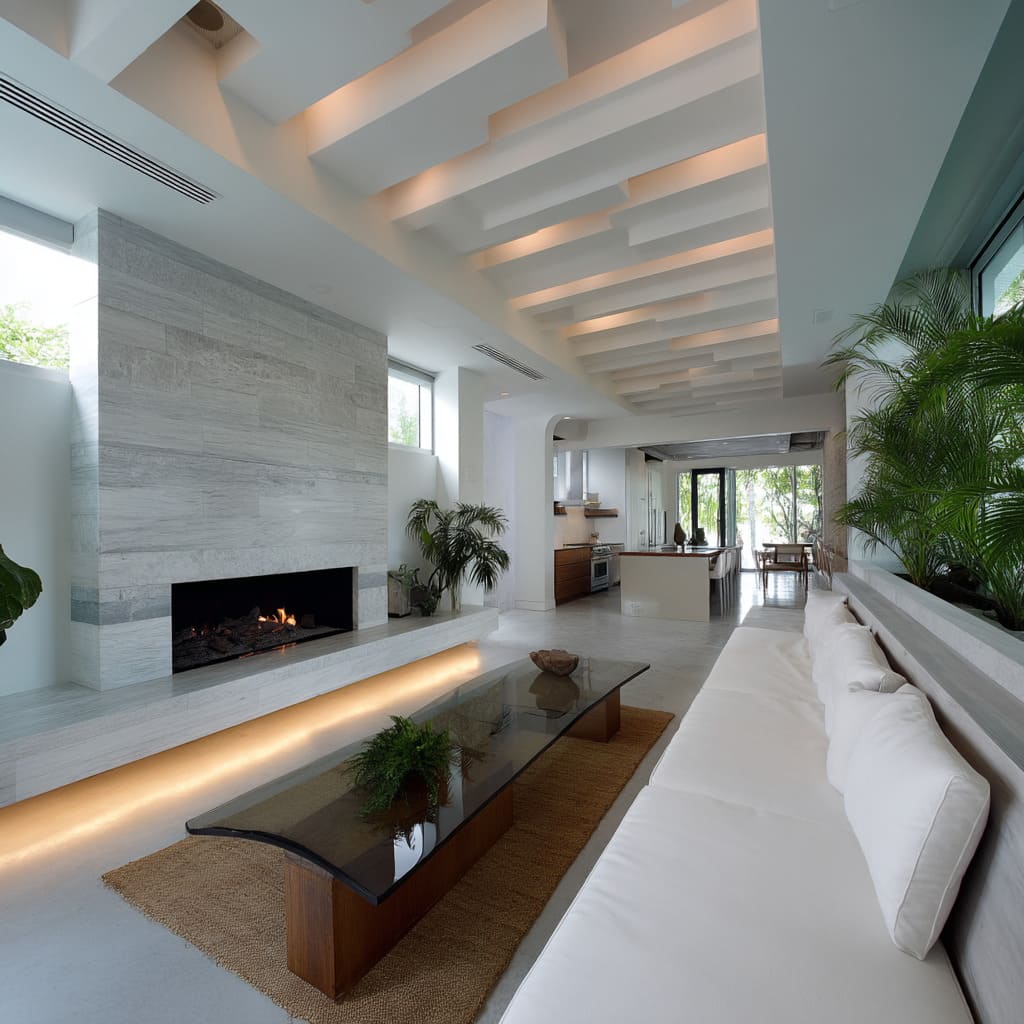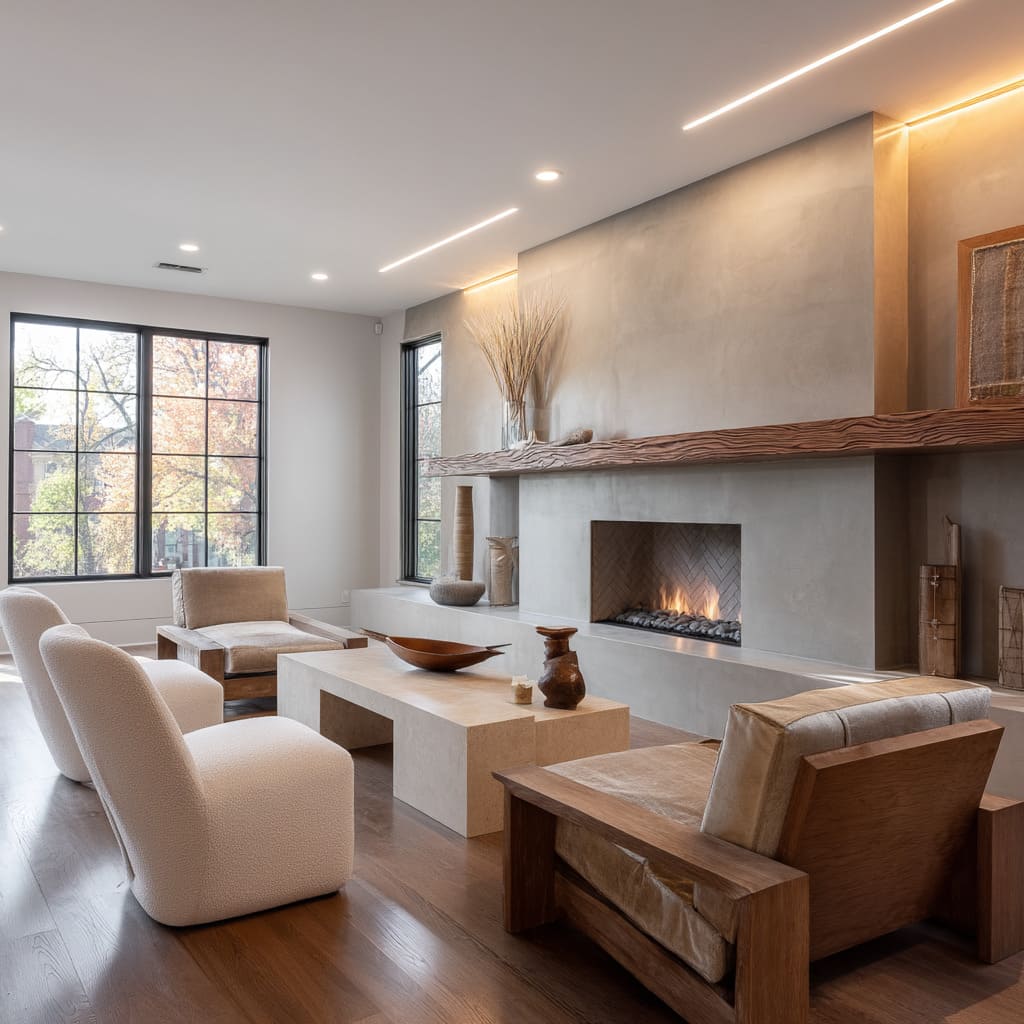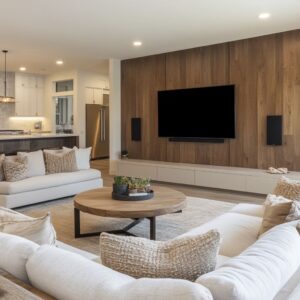The new wave of high-end interiors leans away from flashy surfaces or exaggerated decor and instead leans into a quieter, more grounded sophistication. Think sculptural furniture that feels rooted, natural textures that invite touch, and built-in architectural features that merge function with visual weight.
These modern luxury living room ideas reflect a calm confidence—spaces that feel purposeful, not overdone.
One key shift is the focus on architectural framing, where glass walls and slim black mullions shape the landscape outside as part of the living experience inside. Materials like travertine, board-formed concrete, soft boucle, and lightly brushed oak show up repeatedly—not for show, but for how they absorb light, soften acoustics, and set a rhythm throughout the room.
Instead of relying on color to create contrast, designers are using form, shadow lines, and material transitions.
Lighting is another area where the change is subtle but meaningful. Instead of visible fixtures, many spaces use hidden LED strips, recessed cove lighting, and under-bench glows to sculpt volumes quietly.
Seating is often lower to the ground, blocky, and intentionally unembellished. Even fireplaces have become monolithic art pieces—wrapped in stone, plaster, or wood, often stretching wall to wall or floating just above the floor.
Whether the influence comes from mid-century ranch homes in California, coastal bungalows in Florida, or prairie-inspired layouts in the Midwest, today’s luxury living rooms reflect a consistent theme: quiet structure, warm materiality, and furniture that holds its own through form and texture rather than ornament. It’s a style that feels rooted in craft and clarity, and it’s catching on for a reason.
Precise Framing of Exterior Views
Modern luxury living rooms use substantial windows and thin mullions to fuse interior and exterior. Glass walls become architectural showcases for nearby foliage, or sweeping vistas act as live artwork.
Designers often arrange ceiling planks or floorboards in alignment with the primary view. This directional emphasis encourages the eye to flow outward, turning the landscape into a design feature rather than a mere backdrop.
Notably:.
- Tall, black-framed windows: The dark grid pattern stands out against pale walls, creating graphic lines that reference the outdoors.
- Corner glass wraps: Some spaces use corner windows or seamless corner glazing to dissolve boundaries, making greenery or natural terrain feel continuous with the indoor area.
This approach is not solely about natural light; it’s about integrating nature as a structural and compositional element. Window mullions often echo shapes in the furniture or on accent walls.
Thin frames can intentionally align with tree trunks or stone seams, tying interior patterns to exterior rhythms.
Low, Monolithic Furniture Forms
A recurring theme is substantial, grounded seating and tables that exhibit block-like profiles. Large sofas with solid bases (rather than exposed legs) give a sculptural presence.
Stone or engineered-stone coffee tables appear as single blocks with crisp corners, often balancing more rounded or plush upholstery. This monolithic style:.
- Conveys stability and permanence.
- Mutes visual clutter since the base disappears into a solid mass.
- Reinforces an architectural feeling of built-in solidity.
While these pieces look simple at first glance, designers pay great attention to the subtle contrast of edges. For instance, a cube-like table may have softened corners to prevent an overly harsh geometry against plush textiles.
Or a sofa’s base is fully upholstered, creating a seamless block, yet the seat cushions are overstuffed for a comforting impression.
Contrasts in Texture and Tone
Rather than relying on bright color, most spaces layer nuanced neutrals—ivory, taupe, stone gray, and soft wood tones. The key to preventing monotony in these neutrals is varied texture and finish:.
- Boucle, chenille, or heavy linen upholstery: Provides tactility and visual interest.
- Rough-cut or brushed stone: Adds a quiet, light-catching effect without feeling glossy.
- Natural or lightly stained wood: Retains visible grain and offers a sense of organic warmth.
When color is introduced—like mustard-yellow chairs or rust-colored pillows—it’s done in moderate doses to create a gentle accent rather than a loud statement. This allows the shapes and materials themselves to shine.
One subtle technique is to repeat the accent color’s undertone in adjacent decor pieces, so even small color pops feel cohesive.
Integration of Minimalist Architectural Lighting
Lighting choices frequently focus on indirect or concealed sources that highlight forms and surfaces. Common tactics include:.
- Perimeter cove lighting: Adds an ambient glow and emphasizes ceiling height, corners, or dropped beams.
- Under-ledge LED strips: Create a floating illusion for hearths, benches, or shelves.
- Recessed pin lights: Offer task or accent illumination without introducing large fixtures.
These lights don’t only make the space brighter; they redefine planes and volumes. A cove along a ceiling coffer draws the eye up, while a band of light under a hearth draws attention to the fireplace’s geometry.
Lighting is carefully integrated so that the fixture itself is nearly invisible—what’s left is the visual effect of light shaping the architecture.
Balanced Asymmetry for a Casual Aura
The overall composition often includes asymmetric placements: offset vases, a fireplace ledge extending further on one side, or shelves styled with uneven groups of objects. Despite architectural symmetry (like built-ins flanking a fireplace), the decor arrangement typically breaks perfect mirroring.
This approach keeps the rooms from feeling too formal or predictable. Even in spaces with symmetrical bones—like a coffered ceiling or twin windows—placing accessories off-center fosters a more relaxed and organic vibe.
It also invites the eye to move around the room, noticing details rather than reading the space in a single glance.
Mixed Yet Harmonious Materials
Contemporary luxury no longer relies on matching every finish. Instead, designers blend stone, wood, concrete, metal, and plush fabrics in a way that feels curated:.
- Stone surfaces: Travertine, limestone, or marble with mild veining in a honed finish.
- Natural wood elements: Sometimes reclaimed beams, carved mantels, or minimalist integrated shelving.
- Metal touches: Black steel or brass used sparingly for hearth frames, rods, or table legs.
- Textiles: Layered rugs, accent pillows with subtle patterns, or chunky weaves.
The key is orchestrating these materials with thoughtful transitions. A rough stone fireplace next to a sleek concrete hearth can coexist if their colors align or if lighting is applied to highlight each.
Subtle details—like continuing the same wood species on the ceiling and built-in shelving—reinforce unity within the mix.
Custom Millwork and Built-Ins
From curved banquettes to seamlessly integrated storage, many modern luxury living room designs rely on precise joinery that merges furniture and architecture:.
- Window seats with hidden storage or integrated cushions.
- Fireplace surrounds extended laterally into shelving or media cabinets.
- Floating benches and shelves that appear cantilevered off walls.
The uniform finish on built-ins (e. g., a wood veneer or a color-matched panel) reduces visual segmentation. By blending cabinetry with wall treatments, designers ensure the room reads as a continuous envelope, free of jarring breaks.
In some projects, the chosen wood grain is oriented to follow the lines of the architecture, reinforcing a sense of direction.
Use of Slightly Glossy or Reflective Surfaces
Though a fully glossy interior is rare, designers subtly incorporate sheen:.
- Polished stone coffee tables or fireplace panels that catch subdued reflections.
- Sheen on ceiling wood planks or metal accents that glimmer in indirect light.
- Glass fireplace inserts that reflect the room’s textures, adding dimension.
Gloss is carefully limited so that it doesn’t overpower. A single polished stone element might stand out against mainly matte surroundings, offering a visual anchor and a sense of refined luxury.
Reflection also helps distribute natural light throughout the space, especially in a design that emphasizes muted or darker surfaces.
Emphasis on the Fireplace as Focal Architecture
Often, luxury modern living rooms place the fireplace at the conceptual center. The fireplace wall is often treated as a large-scale installation, featuring:.
- Unique cladding: Board-formed concrete, stacked stone, or large stone slabs.
- Extended hearths: Floating stone benches that run horizontally beyond the firebox.
- Built-in niches: Alcoves for art or shelving, adding dimension and layering.
In some cases, the fireplace is intentionally off-center or offset with an asymmetrical mantle to challenge traditional symmetry. The choice to omit a coffee table in front of the fireplace (seen in a couple of examples) can amplify the fireplace’s presence even more, treating it like a sculptural core rather than a background.
Design Philosophy: Comfortable Minimalism
Despite the term luxury, the majority of living rooms resist any sense of over-decoration. The consistent approach is pared-down but never stark.
Designers focus on:.
- A few statement pieces: A large stone slab table, or an eye-catching overhead installation, instead of many smaller items.
- Organic shapes in furniture or decor: Round chairs, curved banquettes, or fluid forms in vases that add softness to predominantly rectilinear plans.
- Soft layering of neutral textiles: Varied weaves, subtle patterns, and plush surfaces that give depth without busy ornamentation.
By limiting decorative items and emphasizing shape, material, and texture, these spaces maintain a feeling of spaciousness and quiet confidence. The rooms draw attention to craftsmanship—like precisely matched wood grain or expertly bookmatched stone—rather than relying on bold accessories.
Integration of Indoor and Outdoor Themes
Modern luxury living rooms often create a smooth flow between indoor comfort and the natural outside. Even in colder climates, this is done via large windows, cohesive material palettes that echo the environment, or decorative branches mirroring forms in the landscaping.
Seating, rugs, and even accent tables are chosen to harmonize with the earth-toned palette seen through the windows. Objects such as vases holding twigs or driftwood sculptures aren’t just random rustic statements.
They “continue” the story of the outdoor world. When windows frame specific trees or greenery, the interior accessories might echo the tree’s trunk color or leaf shape, subtly linking the two environments.
Tech Integration with Minimal Visual Disruption
Many descriptions mention TVs over fireplaces or flush-mounted screens, yet technology rarely disrupts the aesthetic. Wires are concealed, frames are often black on black to blend with the opening, and speaker systems might be integrated behind slatted wood.
The goal is to keep the focus on architecture and materiality rather than electronics. This quiet approach to technology extends to climate controls or lighting panels, which are often recessed into cabinetry or hidden in side niches.
Luxury living rooms prioritize an uncluttered look, so all technological components are streamlined.
Curated Accessories and Artwork
Although some rooms skip artwork to emphasize form and texture, others incorporate carefully chosen pieces:.
- Large-scale abstracts: Often monochrome or with subtle tonal blocking that reflects the interior’s neutrals.
- Sculptural objects: Clay, ceramic, or wood shapes on coffee tables, hearths, or built-ins.
- Textured wall hangings or woven pieces: Provide warmth without bold color.
Accessories frequently mirror the architectural gestures of the room. For instance, if a fireplace has horizontal striations, you might see horizontal patterns in the artwork.
The approach seems purpose-driven rather than decorative for its own sake—often limiting color so as not to conflict with the room’s dominant palette or the outdoor scenery.
Observations on Current Luxury Trends
- Floating Elements. Hearths, benches, or cabinetry that appears to hover above the floor. This effect conveys modern refinement and introduces shadow lines for visual depth.
- Textured Neutrality. Bold color is kept minimal, replaced by layered neutrals. The interplay of stone finishes, wood grains, and thickly woven fabrics is key to avoiding blandness.
- Architectural Lighting as Sculpture. Ceiling lighting arrangements or geometric LED insets that serve as both illumination and design statement. This transforms the overhead plane into something dynamic.
- Subtle Geometry with Curves. Strategic use of curves—banquette seating, curved accent chairs, and softened corners—breaks up the linear nature of mid-century or contemporary structures. This eases the visual flow while preserving a modern edge.
- Compact Luxury. Even smaller-scale spaces, such as bungalows or cottages, adopt these principles—expansive glazing, custom built-ins, monolithic fireplace walls, and curated neutral furnishings—ensuring the room feels greater than its physical size.
Closing Thoughts
Modern luxury living rooms now focus on clarity of form, a quiet color palette, and a deliberate blend of textures. The true sophistication lies in how details and materials are orchestrated: stone veining aligned seamlessly, grain direction thoughtfully planned, lighting used to accent architecture rather than overwhelm it.
In many instances, the natural world is brought in as a core element, whether through direct line of sight or organic textures that echo an exterior view.
Rather than ornate adornment, the prevailing ethos is sculptural minimalism enriched by organic warmth. Stone, wood, and plush textiles collaborate in layered harmony.
Built-in features, from bench seating to cantilevered shelves, offer functional continuity. Overall, these design narratives prioritize inviting comfort, textural depth, and a sense of calm, all balanced by precise architectural execution.
